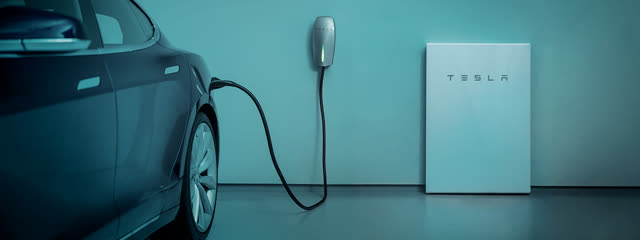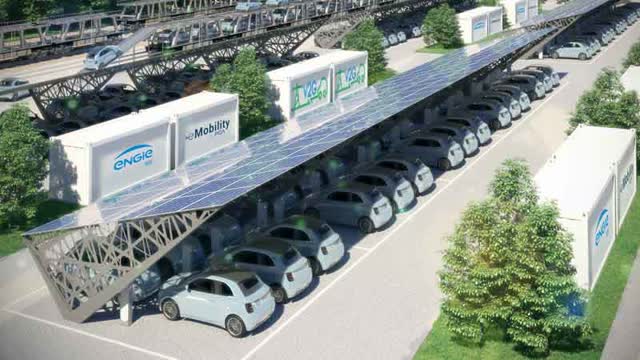Tesla Ready For Import/Export, Taking The BEV Beyond Transport
by Keith WilliamsSummary
- Report that Tesla has (almost) implemented the ability for two-way electricity flows in their BEVs with hardware already largely implemented in the Model 3.
- Tesla keeping its powder dry, perhaps waiting for upcoming battery day.
- Fiat Chrysler partners with ENGIE on a major vehicle-to-grid project.
- Electricity utilities interested in making use of substantial energy store by paying BEV owners for access to their batteries when stationary.
- Another step towards the reality of VPP (Virtual Power Plants).

Tesla charging at home: Source Tesla
There are big changes in train as power and transport get electrified. These two areas of the economy have been major sources of emissions because they have been primarily fossil fuel driven. With the rise of solar PV and wind power, the source of electricity is becoming decarbonised. The rise of the BEV (Battery Electric Vehicle) likewise means that electric power is replacing fossil fuel powered ICE (Internal Combustion Engine) vehicles. A significant potential problem (and solution) concerns the timing of charging a large BEV fleet. BEVs have big batteries and hence a large BEV fleet offers the possibility of providing power management for intermittent renewable energy production. Here, I address what is happening with V2G (Vehicle-to-Grid) systems with special consideration of the role that Tesla (NASDAQ:TSLA) is taking in consolidating this process. It provides yet another reason why I am interested in Tesla.
Tesla and vehicle to grid charging
Nissan (OTCPK:OTCPK:NSANY) pioneered vehicle to grid bidirectional charging 2 years ago, although their solution required the BEV owner to purchase additional technology. It is still early days, with a lot of discussion about how storage capacity of a large BEV fleet will unlock a big energy management resource. BMW (OTCPK:OTCPK:BAMXF) is examining how to participate and Volkswagen (OTCPK:OTCPK:VWAGY) has also indicated that it intends to make its BEV vehicle fleet able to deliver power to the grid as well as to charge. However, today only the Nissan Leaf offers bidirectional charging without voiding the car's battery.
It is important to remember that while Tesla has refused to enable V2G in its vehicles to date, it is a pioneer in the stationary energy scene, being a major player in the development of big batteries for frequency regulation and management of intermittent solar and wind power. It has also pioneered Virtual Power Plant (VPP) developments based on household solar PV and household stationary batteries. The plan has been to connect 50,000 houses in South Australia with an energy management capacity of 250MW. Currently, there are 10,000 residences participating in VPP systems in Australia, which makes the VPP market in Australia similar to that in Germany. In 2019, the estimated total installed residential storage capacity in Australia was estimated to be 336MW.
Tesla has recently applied for a UK power generation licence to further its VPP plans. Whether that will involve big batteries, home solar and residential batteries as well as V2G incorporation remains to be seen.
So, where does Tesla stand with bidirectional charging?
Last week, electrek announced that Tesla has implemented bidirectional charging hardware in the Model 3. Tesla have neither announced not implemented this change, although the electrek article suggests that implementation could be as simple as a software update. In an update (see You Tube link) on that story another engineer suggested that Tesla has not in fact implemented a reversible power system, although it appears that to make the system bi-directional may not involve a major change. If this is so, Tesla is close to implementing a system where the inverter resides in the car and so the BEV could work with a Tesla Wall Connector or any other home charging system. This would make it easy and not involve additional expense to connect up.
In other words, the Tesla solution resides in the vehicle and would come with purchase of the vehicle. This simplifies the process and also the need to spend a significant amount of money installing the means for bidirectional charging at the home. It also means that a Tesla with bidirectional charging enabled could potentially be a resource for energy management wherever it is located.
The silence about this development from Tesla (I have not seen a denial) could mean that this development might become part of a bigger announcement by Tesla, for example, at the upcoming battery day(s).
To date, Tesla has been clear that it offers possibility for bidirectional power movement as part of its VPP development based on rooftop solar PV and its home battery system. It is surely not a big step to incorporate a mobile battery (BEV) into this environment, although it may have some impact on sales of Tesla's Powerwall product. With Fiat Chrysler (see below), Volkswagen, BMW, and just about everyone else getting moving on V2G applications, Tesla must be thinking about it. Putting the technology in the car is a sensible innovation that one might expect of Tesla.
Fiat Chrysler partnering with ENGIE on Italian Vehicle-To-Grid (V2G) project involving hundreds of cars

V2G project Source ENGIE EPS
While Nissan has been relatively quiet about its V2G projects and Tesla has been in hiding, Fiat Chrysler Automobiles (NYSE:FCAU) is developing a substantial V2G pilot with ENGIE EPS, a division of French energy company ENGIE (OTCPK:ENGIY) in Mirafiori in Italy. In the first stage, this involves housing 64 BEVs by July and then 700 BEVs by the end of 2021. This will allow management of 25 MW of electricity at a single site. The facility will also include 5 MW of solar PV capacity. The project is based around the small Fiat 500 electric, being intentionally geared to small economy BEVs, rather than expensive large BEV models. It is not clear how the V2G bidirectional technology will be implemented.
The context for this is that, by 2025, it is anticipated that Europe will have 300 GWh of total energy storage capacity in BEV batteries. This helps one understand why ENGIE is interested and also why the developers of this pilot anticipate that all BEV company fleets will participate in this kind of scheme. Thinking more broadly, why not the parking facilities of all big apartment buildings? Since cars spend most of their time parked, the possibility for grid stabilisation is large. And the BEV owners will receive a reward for participation in a V2G scheme.
Avoiding the need for new fossil fuel power generation by using an emerging BEV fleet to manage energy fluxes
This isn't just happening in Europe, energy utilities around the world, e.g. Australian energy utility AGL (ASX:AGL), have an eye of the rise of the BEV to help solve their energy management problems as renewable energy increases as a percentage of power generation, and to avoid the capital cost of new power provision (eg through gas peakers). The thinking is that a national BEV fleet could be used to not only soak up excess power generated at the wrong times, but also be a source of power when there is a shortfall, with BEV owners being paid for the service they enable.
The above has special relevance in the COVID crisis as there will be a ~10% shortfall in investment in new power generation, especially based on fossil fuels. Investments into oil & gas are projected to fall by ~30%, while shale investment will drop by 50%. Renewable energy investment has been hit less hard and this means that the share of renewables investment in 2020 will increase from ~30% to 40% due to big falls in fossil fuel investment.
As countries begin to assess how to kick-start their economies as COVID-19 becomes more under control, forward-looking planning might accelerate the rise of the BEV. An example of this is a recent announcement by President Macron of a French plan to spend Euro 8.8 billion to make France Europe's top BEV producer with more than 1 million BEVs annually over the next 5 years. This involves expanded subsidies for purchase of BEVs as well as incentives to trade in old ICE cars.
Conclusion
While a lot has been discussed about VPPs (Virtual Power Plants) based on residential solar PV and home batteries, it has been obvious that BEVs have much bigger batteries than home batteries, and they are a bonus as a result of the BEV sitting at home (or at work) for most of the time. To date, this Vehicle-To-Grid technology hasn't really been available, partly because the dots haven't been connected and the business model for VPP firmly established. It may be that VPP will be a subset of a broader V2G strategy as envisaged by the Fiat Chrysler/ENGIE partnership. Now that Tesla looks like it has (almost) implemented a convenient way to charge and discharge one of their BEVs when stationary, it is likely that energy utilities will get more serious about VPPs as they avoid major capital expenditure on building new power plants (and provide a low carbon solution). And for those who think that all of this is far off in the future, I don't think so. Remember a car is an asset that lasts for years, which is why I think a lot of Australian new car buyers are waiting until a BEV policy and V2G is sorted out. A lot of people do not intend to buy another ICE.
Bidirectional charging for a BEV would be yet another example of Tesla cutting through with a convenient solution that has broad applications for both its transport and stationary electricity businesses. It isn't the first in this space, but its implementation will set the pace for other BEV manufacturers to follow. Yet another reason to pay attention to Tesla as it yet again opens up new business opportunities for the company. As for when to buy Tesla, I remain torn between thinking that COVID-19 isn't done with the markets (Tesla above $800, might there be a substantial correction?) and the battery day which might push the stock even higher.
I am not a financial advisor but I pay attention to the electrification of transport (and everything else!). If my commentary helps give you and your financial advisor new insights into the dramatic changes happening in transport and energy, please consider following me.
Disclosure: I/we have no positions in any stocks mentioned, and no plans to initiate any positions within the next 72 hours. I wrote this article myself, and it expresses my own opinions. I am not receiving compensation for it (other than from Seeking Alpha). I have no business relationship with any company whose stock is mentioned in this article.